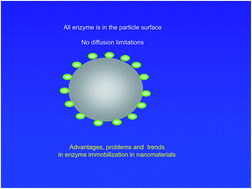Nanomaterials for biocatalyst immobilization – state of the art and future trends
Abstract
Nanotechnology is an area that has been growing over the years, being possible nowadays to find numerous materials constructed at nanoscale. In addition, many applications have been attributed to these “new” materials. In this review is presented a brief overview of nanoparticles used for the immobilization of enzymes. Considering the extensive universe of immobilization in nanoparticles, some were chosen to be exposed here, such as chitosan, graphene, silica, polymers, magnetic, nanoflowers, among others. Advantages, disadvantages and limitations of nanoimmobilization also be discussed. Some applications of nanoimmobilized enzymes are presented, like as biodiesel, flavor synthesis ester and biosensors. The purpose of this paper is to provide an overview of what is being studied in relation to nanoparticles for enzymes immobilization, and some discussions about them, aimed at assisting researchers in future studies and reviews.

- This article is part of the themed collection: Nanomaterial applications


 Please wait while we load your content...
Please wait while we load your content...